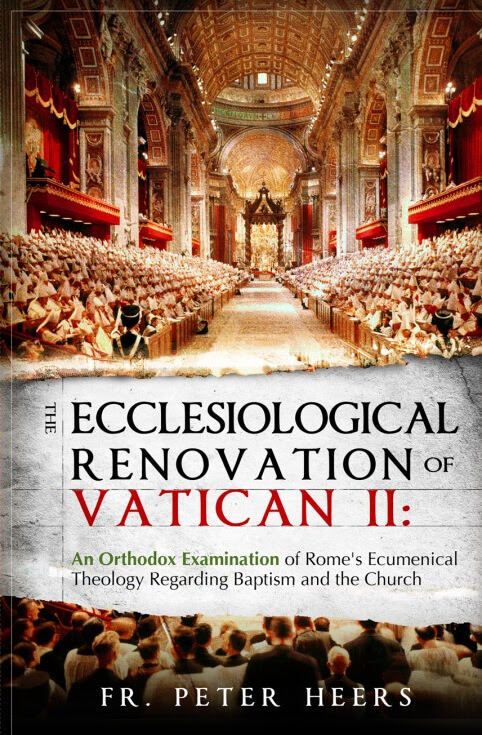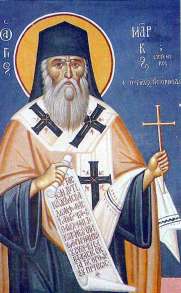On “Partial Ecclesiastical Communion,” the Dominant Theory Behind Contemporary Ecumenism
О «частичном церковном общении», доминирующая теория современного экуменизма
Excerpt from: The Ecclesiological Renovation of Vatican II by Archpriest Peter Heers

The basis for modern Catholic-Orthodox dialogue, the decree [on Ecumenism of Vatican II] established the principle of real, if imperfect, communion between Christians and their churches and communities. - by John Long, S.J.
The idea of partial communion, so central to the new ecclesiology, is inconsistent with this understanding of the organic unity of the Church. Once again, in this regard as well, Vatican II was not a return to the patristic vision of the Church, but rather a further step away from it. As Metropolitan Kallistos Ware has written: “The Bible, the Fathers or the Canons know of only two possibilities: communion and non-communion. It is all or nothing. They do not envisage any third alternative such as ‘partial intercommunion.’” [1] Father Georges Florovsky likewise points out that in the patristic view of the Church “there was simply the question of ‘full communion,’ that is, of membership in the Church. And there were identical terms of this membership for all.” [2]
The identification of “full membership” with “membership in the Church”— a membership based on identical terms for all— could not come into more direct opposition to the heart of the new ecclesiology, which is based upon the possibility of there being degrees of membership in the Body of Christ. This idea stems from the acceptance of a division of the Mysteries from each other and from the Mystery of the Church as a whole. They suppose that Baptism can exist outside the unity of the Church and the other mysteries, mechanically, as it were, imparting membership to those who receive it in separation.
However, just as the Eucharist “is indissolubly bound to the whole content of faith, and likewise to the visible structure of the Church,” [3] so too is Baptism. And, just as “those who advocate intercommunion on the basis of ‘Eucharistic ecclesiology’” treat the Eucharist “too much in isolation (ibid.),” those who advocate a partial communion on the basis of a “common Baptism” likewise consider Baptism too much in isolation. While putting forth Baptism as a point of unity, they fail to realize that, apart from unity in faith and unity in the bishop, unity in a “common Baptism” is impossible. Just as communing together in the Holy Eucharist cannot compensate for, let alone create, unity in faith (ibid.), so too sharing the typos of Baptism (if it is actually shared) cannot create ecclesiastical unity or even a so-called “partial” unity.
Moreover, just as the Eucharist is celebrated and received locally and visibly, such that the separation of the heterodox from participation in the Eucharist is likewise visible and local, so too is Baptism performed in the local Eucharistic Synaxis, from which the heterodox are necessarily excluded. The One Church does not exist as an abstract idea, but is manifested visibly in time and space as the local Church. “One cannot be baptized into the Catholic Church without belonging at the same time to a local Church,” [4] for the local Church, “as an ‘organism,’ a sacramental body, is not a ‘part’ or a ‘member’ of a wider universal organism. It is the very Church itself.” [5] Likewise, one cannot be baptized into the “Catholic Church” of Christ without being in communion with all of the members of the Body, for Christ, the Head of the Church, is inseparable from all of His members. “Why,” asks St. John Chrysostom, “letting go the Head, dost thou cling to the members? If thou art fallen off from it, thou art lost.” [6] Whether one falls from the Head or from the Body, the result is the same: he has lost both the one and the other.
—————
"The Church knows that she is joined in many ways to the baptized who are honoured by the name of Christian, but do not profess the Catholic faith in its entirety or have not preserved unity or communion under the successor of Peter" (Lumen gentium 15). Those "who believe in Christ and have been properly baptized are put in a certain, although imperfect, communion with the Catholic Church" (Unitatis redintegratio 3). With the Orthodox Churches, this communion is so profound "that it lacks little to attain the fullness that would permit a common celebration of the Lord's Eucharist" (Paul VI, Discourse, 14 December 1975; cf. Unitatis redintegratio 13-18). - The Catholic Catechism
—————
There is, therefore, no basis to suppose, as proponents of Unitatis Redintegratio and the new ecclesiology do, that “despite divisions and mutual condemnations all communities of the baptized . . . are in communion,” [7] even if only partially. Communion is one both vertical and horizontal, both with God and among men, both between the Head and His Body, and it is full and only full: “being complete here and complete there also.” [8] The Lord shows no partiality, but distributes the gifts to all alike within the Body. Once united, all become a single house, all are related and brothers in Christ. Just as there can be no partial Christ, there can be no partial communion in Christ, for the Body of communion, “which is his body, [is] the fulness of him that filleth all in all” (Eph. 1: 23). From the moment one is a member, the communion he enjoys in Christ is full, for Christ only gives Himself fully. Whether or not he fully actualizes this self-offering of Christ is not an institutional but an individual issue, and that within the Body.
Whether we speak of one Mystery or another, of Baptism or the Eucharist, one and the same Christ is offering Himself to man, uniting man to Himself. This unity with God is accomplished in the mysteries, all of which have certain presuppositions, first of all, and common to all, unity in faith. That is why what Fr. Dimitru Staniloae insists upon, and warns against, with regard to the Eucharist and “intercommunion” is equally true of Baptism and “partial communion”:
“Ecclesiastical unity, unity in faith, and unity in the Holy Eucharist are all three inseparable and interdependent for the total communion and life in Christ. Consequently, the Orthodox Church cannot accept “intercommunion,” which separates communion in the Holy Eucharist from unity in faith and ecclesiastical unity. More correctly, “intercommunion” is a danger which threatens to destroy the Church, break up the unity of faith and [communion in] the Holy Eucharist [among the Orthodox].” [9]
So, too, the Orthodox Church cannot accept “partial” or “incomplete” communion in a “common Baptism,” for there can be no division between the Mysteries and the Mystery and between Christ in the Mysteries and Christ in whom we believe and trust, whom we confess, and in whom we have our being, our unity. Therefore, the acceptance of an “incomplete communion” between the Church and the heterodox is, like intercommunion in the Eucharist, a grave danger to the unity of the body of Christ. The body of the Church is joined together with the Lord such that, as St. John Chrysostom has written, even the slightest division, the slightest “imperfection” or “incompleteness,” would eventually bring the dissolution of the entire body. ~
Read more here
NOTES:
[1] Archimandrite Kallistos Ware, Communion and Intercommunion: A Study of Communion and Intercommunion Based on the Theology and Practice of the Eastern Church (Minneapolis: Light and Life, 1980), 16.
[2] Fr. Georges Florovsky, “Terms of Communion in the Undivided Church,” in Intercommunion. The Report of the Theological Commission Appointed by the Continuation Committee of the World Conference on Faith and Order together with a Selection from the Material Presented to the Commission, ed. D. Baillie and John Marsh (London, 1952), 50, as quoted in Ware, Communion and Intercommunion, 16– 17. Professor George Galitis is also quoted by Ware in the same vein, that in the ancient Church “there is only communion and non-communion” (G. Galitis, The Problem of Intercommunion with the Heterodox from an Orthodox Point of View: A Biblical and Ecclesiological Study [in Greek] [Athens, 1966], 24– 25.) It is important to note that Fr. Georges Florovsky, whose views are often cited in support of versions of theories of baptismal theology-ecclesiology, quite early on explicitly qualified his scholarly musings on the views of St. Augustine and stated that the Saint’s views were “no more than a ‘theologoumenon,’ a doctrine set forth by a single Father.” Likewise, he urged the Orthodox to take it into account, not for its own sake or on its own terms, and certainly not as it has been played out within Latin theology, but simply as one view that can aid in the formation of a “true ecumenical synthesis.” Indeed, Fr. Florovsky lamented that the Orthodox have too often expounded upon the doctrine of the sacraments using the Roman model, without any creative or transforming adoption of St. Augustine’s conception. On the contrary, Fr. Florovsky formally and firmly rejected the theory of primordial unity in a common Baptism as is stressed by Roman Catholicism, explaining that it, like the Protestant branch theory, glosses over and minimizes the scandal of “dis-union,” which for him was to be faced forthrightly and explained in terms of “the true [Orthodox] Church and secessions.” Florovsky stressed the unity of the mysteries, especially the first three, and hence thought less in terms of regeneration linked to Baptism than of incorporation into the common Body of Christ in the Eucharist. See Andrew Blane, Georges Florovksy, Russian Intellectual and Orthodox Churchman (Crestwood, NY: St. Vladimir’s Seminary Press, 1997), 311– 17.
[3] Ware, Communion and Intercommunion, 20.
[4] Ware, Communion and Intercommunion, 23.
[5] Schmemann, “Unity, Division, Reunion.”
[6] PG 62.344.36: Τί τοίνυν τὴν κεφαλὴν ἀφεὶς, ἔχει τῶν μελῶν; ἐὰν ἐκεῖθεν ἐκπέσῃς, ἀπόλωτας.
[7] Jorge A. Scampini, “We acknowledge one Baptism for the forgiveness of sins,” address given at the Faith and Order Plenary Commission in Kuala, Malaysia, July 28– August 6, 2004. It is significant to note that Pope John Paul II, in his encyclical Ut Unum Sint (par. 42), linked this idea of deep communion in spite of division to “baptismal character,” thus following faithfully the precedent established by Congar, Bea, and Vatican II: “The very expression separated brethren tends to be replaced today by expressions which more readily evoke the deep communion— linked to the Baptismal character— which the Spirit fosters in spite of historical and canonical divisions. Today we speak of “other Christians,” “others who have received Baptism,” and “Christians of other Communities.” . . . This broadening of vocabulary is indicative of a significant change in attitudes. There is an increased awareness that we all belong to Christ.”
[8] PG 63.131.39, Saint John Chrysostom, Homily on the Epistle to the Hebrews, 17.6.
[9] Dimitru Staniloae, Γιὰ ἕναν Ὀρθόδοξο Οἰκουμενισμὸ [Toward an Orthodox Ecumenism] (Athens, 1976), 29.

